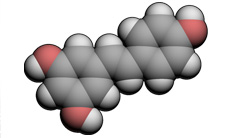







Hydroxystilbene. A potent polyphenol
Polyphenols, also known as tannins represent a diverse group of compounds containing multiple phenolic functionalities and are widely distributed in nature. Polyphenols are also the largest groups of tyrosinase inhibitors until now. Polyphenols can be subdivided into the following categories:
Flavonoids
Flavonoids are natural plant polyphenols found in leaves, bark and flowers. Flavonoids belong to the most numerous and best studied group of plant polyphenols. Some 4,000 members have been identified to date, all benzo-γ-pyran derivates comprised of phenolic and pyran rings. Flavonoids may have hypopigmenting capabilities by directly inhibiting tyrosinase activity at distal portions of the melanogenic pathway. It has been reported that flavonoids inhibit enzymes due to their abilities to chelate copper at the active site and may also have ROS scavenging properties Structure-function analysis of flavonoids suggests that flavonoids with an α-keto group show potent tyrosinase inhibition due to the similarity between the dihydroxyphenyl group of DOPA and the α-keto containing flavonoids.
Flavonoids are classified into six major groups flavones, flavonols, flavanones, isoflavonoids, flavanols (catechin), anthocyanidins. These groups differed in the conjugation of rings and the position of hydroxyl, methoxy and glycosidic groups.
- Flavones. Flavones (flavus = yellow), are a class of flavonoids based on the backbone of 2-phenylchromen-4-one (2-phenyl-1-benzopyran-4-one) . Natural flavones include Apigenin (4',5,7-trihydroxyflavone), Luteolin (3',4',5,7-tetrahydroxyflavone) and Tangeritin (4',5,6,7,8-pentamethoxyflavone), chrysin(5,7-OH), 6-hydroxyflavone, baicalein (5,6,7-trihydroxyflavone), scutellarein(5,6,7,4'-tetrahydroxyflavone), wogonin (5,7 -OH, 8 -OCH3). Synthetic flavones are Diosmin and Flavoxate.
- Flavonols. Flavonols (with an "o") are a class of flavonoids that have the 3-hydroxyflavone backbone (IUPAC name : 3-hydroxy-2-phenylchromen-4-one). Their diversity stems from the different positions the phenolic -OH groups. Many flavonols have been isolated from plants, and some were identified as tyrosinase inhibitors. The inhibitory mode of flavonol inhibitors is usually competitive inhibition for the oxidation of l-dopa by tyrosinase and the 3-hydroxy-4-keto moiety of the flavonol structure acts as the key role in copper chelation. Although many flavonols have been identified as competitive tyrosinase inhibitors, most flavonol inhibitors are very weak inhibitors with most of them acting at about 1 mM; Quercetin is present as glycosylated derivatives in onions, flowers of mexican Heteroteca inuloides and Trixis michuacana and Arnica montana. Kaempferol is found in petals of Crocus sativus (saffron). Its 3-O-glucoside does not inhibit tyrosinase (Kubo and Kinst-Hori, 1999). Mulberroside F (moracine M-6) is obtained from the Morus alba leaves, and it greatly decreases melanin formation in normal melanocytes. The most active flavonol, quercetin is more effective than its analogues kaempferol and morin but showed only 20% of the inhibitory strength of kojic acid toward diphenolase activity of mushroom tyrosinase. Hence, it is obvious that these flavonol inhibitors have little potential in applications of skin whitening or food antibrowning.
- Chalcones. Chalcones, also named flavanones, consist of two aromatic rings in trans configuration, separated by three carbon atoms. Flavanones are a type of flavonoids. They differ from other flavonoids by the absence of the double bond at the 2–3 position of the pyrone ring. They are generally glycosylated by a disaccharide at position seven to give flavanone glycosides. Some natural prenylated chalcones showed potent tyrosinase inhibitory activity. A systematic study about the influence of number and position of hydroxyl groups on the basic ring indicated the importance of the position 4 on the ring B. Isoliquiritigenin chalcone (2′,4′,4-trihydroxychalcone) and butein were the most potent tyrosinase inhibitors, although curiously also shortened the typical lag period known for the monophenolase activity of this enzyme. A study on the influence of number and position of hydroxyl groups on the basic ring of chalcones indicated the importance of position 4 on the ring B. Another study indicates that the 2,4-resorcinol subunit on ring B is very important for inhibition, as changing to resorcinol substitution to position 3,5 or placing it on ring A significantly abrogates the inhibitory effect of the compounds. Nevertheless, all these studies were conducted only on mushroom tyrosinase.
- Isoflavonoids. Isoflavonoids are a class of flavonoid polyphenolic compounds. They are biologically active compounds, such as phytoestrogens. Isoflavonoids are derived from the flavonoid biosynthesis pathway via liquiritigenin or naringenin. The extracts from the roots and seeds of Glycyrrhiza species (Leguminoseae) have long been regarded as an effective constituent for skin-whitening agents in East Asian countries. The melanogenesis inhibitory activity of the extracts mainly comes from the isoflavonoids in the plant. Two isoflavans were purified from the roots of the plant and identified as potent tyrosinase inhibitors. Glabridine was the first confirmed inhibitor with 15 times activity of kojic acid and exhibited higher depigmenting activity than that of arbutin. In contrast, glabridine’s analog, glabrene, was found to be 100-fold less active than glabridine. Kinetics study showed that glabridin and glabrene inhibited the enzyme with non-competitive and uncompetitive modes, respectively.
- Flavanols. Flavanols (also referred to as Flavan-3-ols) are a class of flavonoids that use the 2-phenyl-3,4-dihydro-2H-chromen-3-ol skeleton. Flavanols possess two chiral carbons meaning there are 4 diastereoisomers for each of them. These compounds include the catechins and the catechin gallates. Catechins are differentiated from the ketone-containing flavonoids such as quercitin and rutin, which are called flavonols. The term bioflavonoid was first used to describe the flavonols, but as an imprecise term has been loosely applied to the larger family of flavonoids, including also the polymeric hydroxyl-only containing flavanols. Similarly to flavonols, most flavanols inhibitors exhibited only weak to moderate inhibitory strength of the enzyme tyrosinase.
- Procyanidins. Procyanidins, polymers of catechins found in tea and fruits such as apples and grapes had been recently introduced as inhibitors of melanogenesis. Procyanidinrich extract would reduce DOPA-postive melanocytes and 8-hydroxy-2′-deoxyguanosine positive melanin containing cells, and this effect may related to inhibition of tyrosinase and ROS-induced melanocytes proliferation. Studies have shown that procyanidin administered at a dose of 1.10 mg/kg for 4–8 weeks significantly prevented UV radiation-induced erythema in humans. Procyanidins that have potent tyrosinase inhibitory capacity have been found in tea and fruits like apple and grape. They are good-antioxidants and have been recently introduced as inhibitors of melanogenesis in B16 mouse melanoma cells (Shoji et al., 2005) and as agents that reduce cell viability in some melanoma cells by arresting cells in S-phase (Lozano et al., 2005). Oral administration of proanthocyanidin-rich grape seed extract has been found to be effective in lightening the UV-induced of guinea pigs skin probably through its capability of inhibiting both tyrosinase activity and oxidative stress-mediated proliferation of melanocytes (Yamakoshi et al., 2003). The efficacy of pyogenol, a standardized extract of the pine bark containing catechin, epicatechin and procyanidins, in the treatment of melasma has been successfully tested (Ni et al., 2002). Proanthocyanidin-rich grapeseed extract (GSE) strongly suppresses melanin pigment formation, and the feeding of GSE has an apparent lightening effect on UV-induced hyperpigmentation in guinea pig skin.
- Anthocyanidins. Anthocyanidins are common plant pigments with tyrosinase inhibitory properties. Next to chlorophyll, anthocyanins are the most important group of plant pigments visible to the human eye. They are the sugar-free counterparts of anthocyanins based on the flavylium ion or 2-phenylchromenylium which is a type of oxonium ion (chromenylium is referred also to as benzopyrylium).They form a large group of polymethine dye. In particular anthocyanidins are salt derivatives of the 2-phenylchromenylium cation, also known as flavylium cation. The counterion of the flavylium cation is mostly chloride. With this positive charge, the anthocyanidins differ from other flavonoids. Anthocyanidins with skin lightening properties include mulberry fruit, Acerola and pomegranate.
Stilbenes
A stilbene consists of an ethene double bond substituted with a benzyl ring on both carbon atoms of the double bond. Some of the more efficient pigment lightening flavonoid subcategories are the hydroxystilbene compounds, derived from natural products found in oriental herbal medicines. Commonly studied hydroxystilbene products include resveratrol (3,4’,5 trihydroxystilbene), its isomer oxyresveratrol and methoxylated or glycosylated analogs piceid-glucoside, rhapontigenin and rhaponticin. Which are effective whitening agents probably due to their high affinity to tyrosinase. Oxyresveratrol (2,4,3′,5′-tetrahydroxy-trans-stilbene), which was initially isolated from Morus alba, exhibited 32-fold more inhibitory activity than that of kojic acid. The inhibitor acts non-competitively on both monophenolase and diphenolase activity of mushroom tyrosinase. Based on the potent inhibitory capacity, oxyresveratrol reduced pigmentation in melanoma cells. The melanogenesis inhibitory mechanism of the compound was proved to directly inhibit enzyme activity but not affect gene expression. It is worth noting that oxyresveratrol also contains the structure of the 4-resorcinol moiety in the B ring and the 5-resorcinol moiety in the A ring as described in the former “chalcone” section. In fact, oxyresveratrol is 50-fold more active than its analog, resveratrol (2,3′,5′-trihydroxy-trans-stilbene), which loses the 4-resorcinol moiety in its structure. It had also been investigated that melanogenesis was inhibited by the Ramulus mori extract that contains 2-oxyresveratrol. The hydroxystilbene products still require more analysis to properly elucidate their pigment lightening effect and mechanism(s) of action.
Coumarins
Coumarins are lactones of phenylpropanoid acid with an H-benzopyranone nucleus. Among the coumarin-type tyrosinase inhibitors, aloesin (2-acetonyl-8-D-glucopyranosyl-7-hydroxy-5-methylchromone) is the famous one, which is a natural hydroxycoumarin glucoside isolated from Aloe vera It. has been proven to competitively inhibit tyrosinase from human, mushroom, and murine sources with more inhibitory activity toward crude murine tyrosinase than mushroom tyrosinase. It modulated melanogenesis via competitive inhibition of tyrosinase. It competitively inhibits the function of tyrosinase by inhibiting the hydroxylation of tyrosine to DOPA and oxidation of DOPA to dopaquinone. Studies have shown that tyrosine hydroxylase and DOPA (3,4-dihydroxyphenylalanine) oxidase activities (of tyrosinase from normal human melanocyte cell lysates) are inhibited by aloesin in a dose-dependent manner. Similarly, studies on the topical application of aloesin on UV-irradiated human volar forearm showed pigmentation suppression in a dose-dependent manner. The hydrophilic nature of the compound reduces the skin penetration of aloesin. Hence, combination treatment of aloesin with arbutin has been studied to assess the synergistic effects on tyrosinase activity. The two adhere to different mechanisms of action where aloesin exhibits noncompetitive inhibition while arbutin inhibits. Testing of aloesin revealed no cytotoxicity, which makes it a good alternative to HQ.
Chalcones
Chalcones consist of two aromatic rings in trans configuration, separated by three carbon atoms, of which two are connected by a double bond and the third is a carbonyl group. Results from recent studies showed chalcones are potent new depigmentation agents, with a double effect of tyrosinase inhibition and antioxidant activity. The most important factor in their efficacy is the location of the hydroxyl groups on both aromatic rings, with a significant preference to a 4-substituted B ring, rather than a substituted A ring. Neither the number of hydroxyls nor the presence of a catechol moiety on ring B correlated with increasing tyrosinase inhibition potency.
Ellagic Acid
Ellagic acid is a natural polyphenol that is widely found in fruits and vegetables including berries, green tea and pomegranate with strong antioxidative properties and tyrosinase inhibition. The extract of the rinds of pomegranate contains 90% ellagic acid and showed inhibitory activity against mushroom tyrosinase in vitro. The The mechanism of action of ellagic acid may due to chelating copper at the active site of tyrosinase to reduce its activity and inhibition of proliferation of melanocytes and melanin synthesis. In addition, the antioxidative and ROS-scavenging activities of EA may contribute to its skin-whitening effect.
>
>
>
>
>
>
>
>
>
>
>
>
>
>
>
>
>
>
TYROSINASE INHIBITORS
Polyphenols
Benzaldehyde and Benzoate Derivatives
Gallic Acid and Derivatives
Long-Chain Lipids and Steroids
INHIBITORS OF MELANOSOMAL TRANSFER
Centaureidin and Methylophiopogonanone B
Niacinamide
PAR-2 Inhibitors
Lectins and Neoglycoproteins
ANTIOXIDANTS
Glutathione
Vitamin C
Alpha Tocopherol and Alpha Tocopherol Ferulate
ACCELERATORS OF EPIDERMAL TURNOVER AND DESQUAMATORS
α-Hydroxyacids
Salicylic Acid
Linoleic Acid
Retinoids
TRANSCRIPTIONAL REGULATION OF MELANOGENIC ENZYMES
The MAPK Pathway
MC1R
cAMP Pathway and MITF

<< Previous: TYROSINASE INHIBITORS: Introduction
Next: Benzaldehyde and Benzoate Derivatives >>